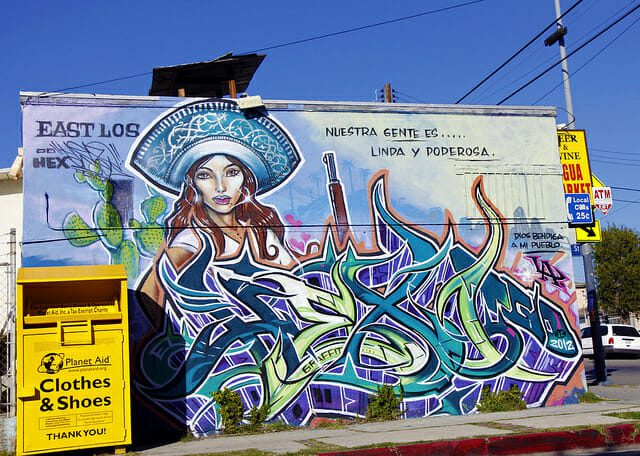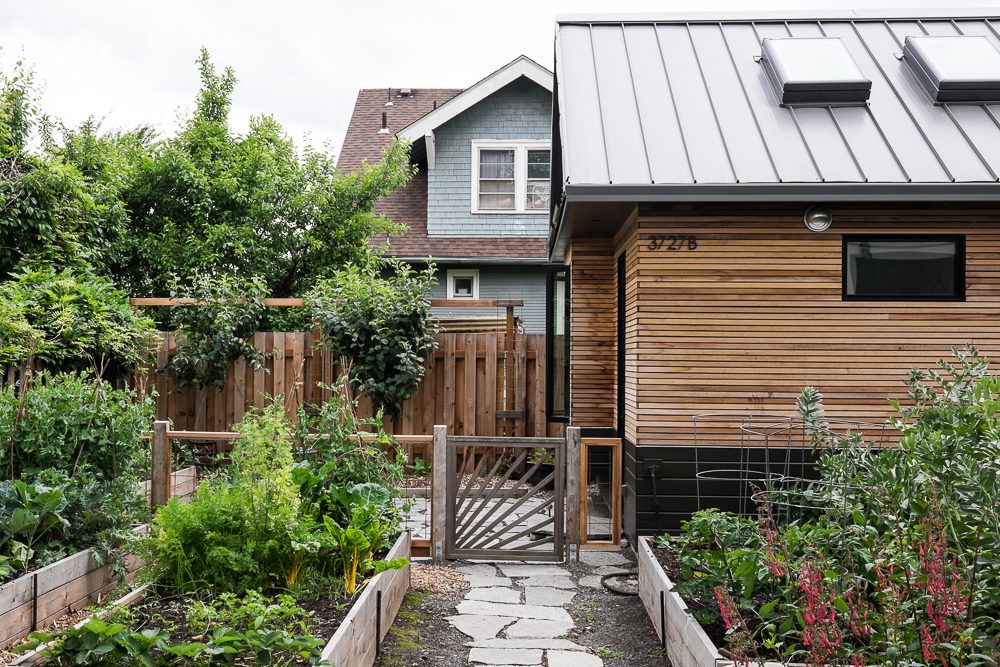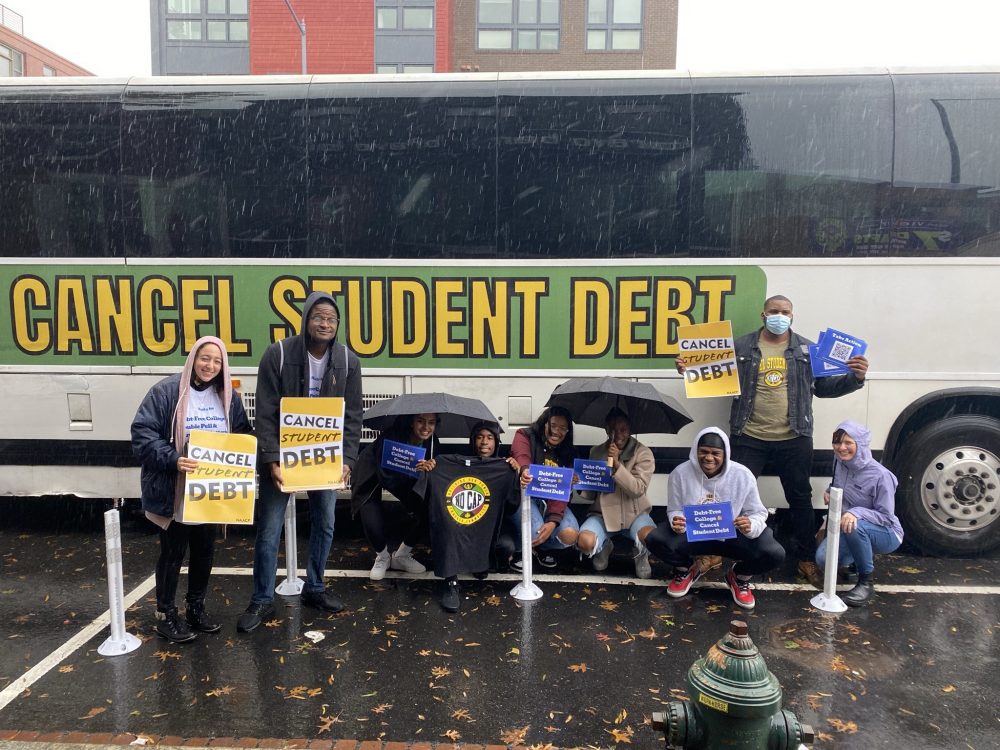
‘Boyle Heights Mural.’ Photo by johndoeforty1 via flickr, CC BY-NC-ND 2.0
“It is easy for art people to empathize with struggles that take place 8,000 miles away, unencumbered by personal loyalties or self-interested agendas. It is harder to identify with the neighbor across the river, because it teases out the privilege of the art crowd and the stakes become concrete and material.”—Nizan Shaked, a former editorial board member of an L.A. art publication, penned an eloquent resignation letter last month when the publication decided to hold an event at a Boyle Heights gallery space—one of several that protesters have said has helped hasten gentrification of the working-class neighborhood.
Advocates are working to pass source-of-income protection in New York State by adding “lawful source of income” to the list of protected classes under the state’s human rights statute, which would prohibit landlords from discriminating against people with non-wage sources of income such as Housing Choice Vouchers. After a lobby day, the group has picked up the support of former HUD Secretary Governor Andrew Cuomo, who is busy swinging left as he faces a primary challenge from Cynthia Nixon. (Did we say that last part out loud?) Hey, we’ll take it.
Few Shelterforce readers are unaware of the mixed blessings that can follow massive public investment in a place that has been allowed to suffer for a long time. But even we took a deep breath at the thought of Detroit’s Michigan Central Station—which taught most of us the term “ruin porn”—being turned into a privately owned tech hub. Huffington Post breaks down the ambivalence.
Ah, data…
We appreciate the Victoria Transport Policy Institute calling out a recent report’s claim that families do not save much by moving to transportation-rich areas. Data can (and often, should) be manipulated to support various arguments, but it takes robust critique from all sides to keep us working toward a goal of the actual truth.
We also appreciate this libertarian economist’s intellectual honesty in publishing findings that clearly go against his ideology. No matter how he and his student assistant sliced the data, he couldn’t prove that federal regulations negatively affected business growth, but published his findings anyway. That we’re generally shocked by this and moved to commend him is sad commentary in itself, but the times we live in call for holding up the good [news].
Mick Mulvaney may have admitted that he actually doesn’t prioritize banks over people . . . just money.
It’s happening yet again—African-American households being targeted for legal but questionably ethical contract-for-deed home buying arrangements that leave the buyer with all of the responsibilities of ownership, but no equity until the whole mortgage is paid off. (Latinx households on the border have also struggled with this.) While you can do rent-to-own ethically, the terms of this new wave of products are predatory and totally unethical if the buyers don’t fully understand what they are getting into, which most don’t. Fair housing advocates are arguing that the targeting of African-American households specifically, in neighborhoods hard hit by subprime lending, also constitutes a fair housing violation. Sounds right.
Could the CRA become the RA? The Office of the Comptroller of the Currency proposes “modernization” of the Community Reinvestment Act, which includes “updating the definitions of geographic assessment areas to reflect the changing nature of banking arising from changing technology, customer behavior, and other factors” and downplaying the importance of branches. The Wall Street Journal suggests they are actually considering getting rid of geographic assessment areas all together. While the world is definitely changing, nothing in the research shows that physical place and the uneven distribution of opportunities and access within those places is any less important than it was in the 1970s. In fact, all indications are that place is still extremely important, and banking deserts matter. Removing a geographic lens from CRA seems like a dubious move—unless of course it means that on top of a responsibility to lend in places they receive deposits, financial institutions also have to make reparations to the markets they’ve abandoned entirely.
A little good news (along with the Senate vote to restore net neutrality)—the draft FY 2019 spending bill of the House of Representatives appropriations subcommittee that oversees funding levels for affordable housing and community development programs at HUD is not terrible! The National Low Income Housing Coalition reports that the bill maintains the 10 percent increase won in the FY 2018 bill, and rejects many of the cruel and counterproductive administration proposals. Unfortunately, it still doesn’t contain enough funding to renew all the existing vouchers (which as we know, only reach 1 in 5 people who are eligible for them already).
Amazon is showing its true colors again. The company, one of Seattle’s largest and most powerful employers, suspended its expansion plans after city officials proposed a new tax to fund affordable housing. The ordinance, which passed this week, imposes a “head tax” on businesses that generate more than $20 million a year and is expected to raise $47 million a year for affordable housing. The approved bill will bring in far less money for affordable housing than the city originally proposed, which is more than likely due to Amazon essentially holding the city hostage. To us, the company has erased any good karma it earned when it created a temporary 200-plus bed homeless shelter on its campus.
A senior residence that will include more than 80 LGBT-friendly affordable apartments in the Bronx broke ground this week. SAGE and HELP USA held the groundbreaking ceremony for Crotona Senior Residences on the International Day Against Homophobia, Transphobia and Biphobia. SAGE, which advocates and provides services for LGBT elders, also launched a campaign this week—Care Can’t Wait—to gather support for LGBTQ seniors under threat of discrimination. “Imagine the person you love being denied essential care in a nursing home or being turned away from a hospital simply because of who they are and who they love. We cannot allow this to happen.”
We already know there’s a lot of controversy about the way Low-Income Housing Tax Credits (LIHTC) are distributed, but can Qualified Allocation Plans serve as a tool to direct those credits to neighborhoods that offer more resources? That’s the crux of this analysis, which “provides the first source of empirical evidence that state allocation plans can shape LIHTC siting patterns.” It’s worth the read.
The National Fair Housing Alliance released its 2018 housing trends report, Making Every Neighborhood a Place of Opportunity. The report takes a look at the past 50 years of fair housing; recent attacks on fair housing, including what’s happening with the Affirmatively Furthering Fair Housing provision, the dismantling of the Consumer Financial Protection Bureau, and the use of faith as a license to discriminate; an overview of recent housing discrimination; and challenges and recommendations for the future.
Vacant land: Should it be used for community gardens or affordable housing? Fifteen percent of land in most U.S. cities is vacant, and ideas about what to do with that land can create tension among residents, city officials, and developers. This highlights what’s been happening across the country, including New York, where council members passed a bill so that urban farmers and gardeners have a say in how land they’ve cultivated and maintained is used in the future. (And for more about community land, check out these essays where folks across the country explain what community control of land means to them.)
Mural art has long been perceived as a kind of visual stamp against the cultural erasure that can come with neighborhood change, and their use around the world is widespread. In Australia’s historically indigenous neighborhood of Redfern, a local community group had been lobbying for restoration of a 30 year-old mural depicting the history and people there. The restoration project was finally approved, with the project led by an indigenous artist and worked on by students and conservationists.
We hear lots of stories of galleries being bellwethers of gentrification, but the Chicano Humanities and Arts Council (CHAC) in La Alma, a Mexican enclave in West Denver, was a gallery that had helped to launch many artists’ careers. As the neighborhood changes and real estate prices rise, the gallery’s landlord wishes to sell and CHAC must move several blocks away, and for higher rent.
An activist group staged a protest inside the Brooklyn Museum to speak against its hiring of a white person for a consulting curator of African art position, and called for the museum to replace some board members with artists and community organizers as well as make a commitment to diversity on the institution’s staff.
We’ve already discussed the flawed assumptions in the government’s new work requirements for people receiving social services and Medicaid, but Michigan’s approach to exempting some of those recipients may promote the harmful narrative of the “deserving poor”. If following unemployment maps, numbers in predominantly Black areas with high unemployment may be diluted because of their close proximity to low-unemployment suburbs. The opposite effect is present in rural, mostly white areas, that might be exempt from requirements simply because of their more isolated location. This geographic (and structural) phenomena is present in several states exploring work requirements. Adding insult to work requirements’ injury …




Comments